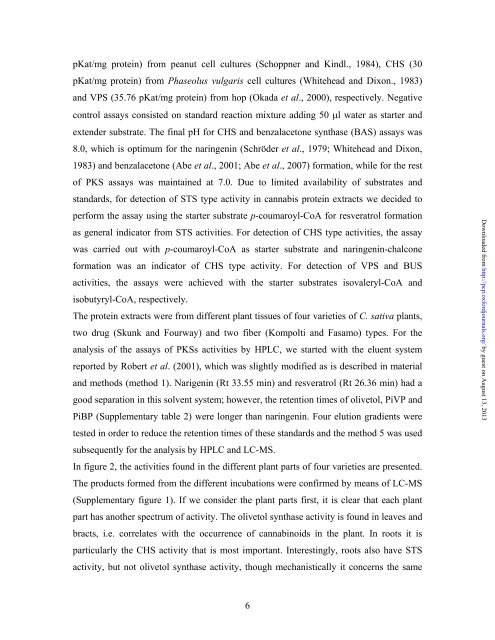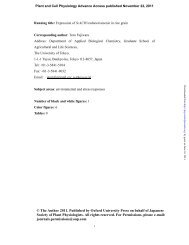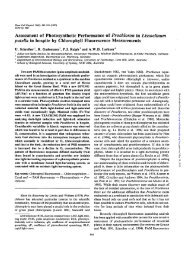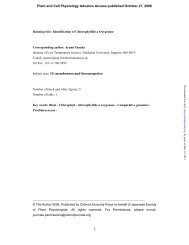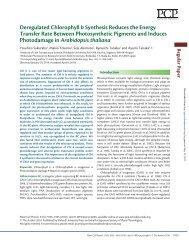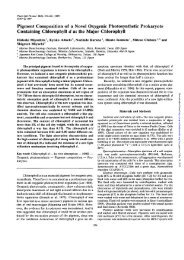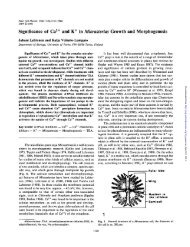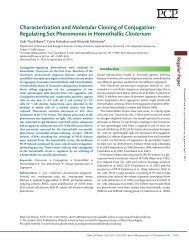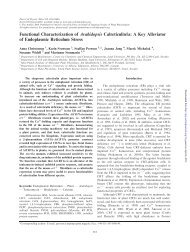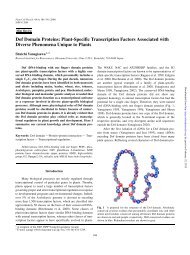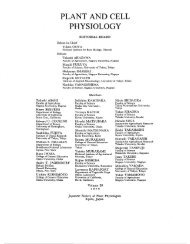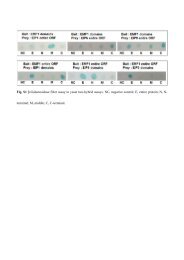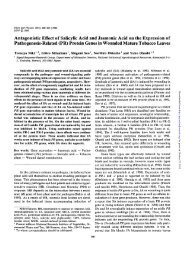1 Running title: PKSs and, cannabinoid and flavonoid accumulation ...
1 Running title: PKSs and, cannabinoid and flavonoid accumulation ...
1 Running title: PKSs and, cannabinoid and flavonoid accumulation ...
You also want an ePaper? Increase the reach of your titles
YUMPU automatically turns print PDFs into web optimized ePapers that Google loves.
pKat/mg protein) from peanut cell cultures (Schoppner <strong>and</strong> Kindl., 1984), CHS (30<br />
pKat/mg protein) from Phaseolus vulgaris cell cultures (Whitehead <strong>and</strong> Dixon., 1983)<br />
<strong>and</strong> VPS (35.76 pKat/mg protein) from hop (Okada et al., 2000), respectively. Negative<br />
control assays consisted on st<strong>and</strong>ard reaction mixture adding 50 µl water as starter <strong>and</strong><br />
extender substrate. The final pH for CHS <strong>and</strong> benzalacetone synthase (BAS) assays was<br />
8.0, which is optimum for the naringenin (Schröder et al., 1979; Whitehead <strong>and</strong> Dixon,<br />
1983) <strong>and</strong> benzalacetone (Abe et al., 2001; Abe et al., 2007) formation, while for the rest<br />
of PKS assays was maintained at 7.0. Due to limited availability of substrates <strong>and</strong><br />
st<strong>and</strong>ards, for detection of STS type activity in cannabis protein extracts we decided to<br />
perform the assay using the starter substrate p-coumaroyl-CoA for resveratrol formation<br />
as general indicator from STS activities. For detection of CHS type activities, the assay<br />
was carried out with p-coumaroyl-CoA as starter substrate <strong>and</strong> naringenin-chalcone<br />
formation was an indicator of CHS type activity. For detection of VPS <strong>and</strong> BUS<br />
activities, the assays were achieved with the starter substrates isovaleryl-CoA <strong>and</strong><br />
isobutyryl-CoA, respectively.<br />
The protein extracts were from different plant tissues of four varieties of C. sativa plants,<br />
two drug (Skunk <strong>and</strong> Fourway) <strong>and</strong> two fiber (Kompolti <strong>and</strong> Fasamo) types. For the<br />
analysis of the assays of <strong>PKSs</strong> activities by HPLC, we started with the eluent system<br />
reported by Robert et al. (2001), which was slightly modified as is described in material<br />
<strong>and</strong> methods (method 1). Narigenin (Rt 33.55 min) <strong>and</strong> resveratrol (Rt 26.36 min) had a<br />
good separation in this solvent system; however, the retention times of olivetol, PiVP <strong>and</strong><br />
PiBP (Supplementary table 2) were longer than naringenin. Four elution gradients were<br />
tested in order to reduce the retention times of these st<strong>and</strong>ards <strong>and</strong> the method 5 was used<br />
subsequently for the analysis by HPLC <strong>and</strong> LC-MS.<br />
In figure 2, the activities found in the different plant parts of four varieties are presented.<br />
The products formed from the different incubations were confirmed by means of LC-MS<br />
(Supplementary figure 1). If we consider the plant parts first, it is clear that each plant<br />
part has another spectrum of activity. The olivetol synthase activity is found in leaves <strong>and</strong><br />
bracts, i.e. correlates with the occurrence of <strong>cannabinoid</strong>s in the plant. In roots it is<br />
particularly the CHS activity that is most important. Interestingly, roots also have STS<br />
activity, but not olivetol synthase activity, though mechanistically it concerns the same<br />
6<br />
Downloaded from<br />
http://pcp.oxfordjournals.org/ by guest on August 13, 2013


